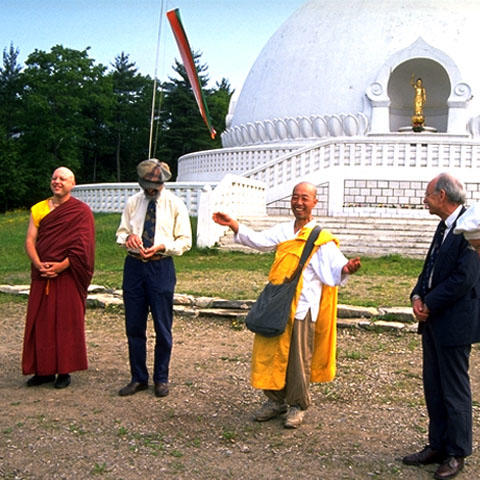
Pioneered by the Vietnamese monk Thich Nhat Hanh in the 1970s, “Engaged Buddhism” brings a Buddhist perspective to the ongoing struggle for social and environmental justice in America.
View full album
Some observers may associate Buddhism, and especially Buddhist meditation, with turning inward away from the world. However, many argue that the Buddhist tradition, with its emphasis on seeing clearly into the nature of suffering and, thus, cultivating compassion, has a strong impetus for active involvement in the world’s struggles. This activist stream of Buddhism came to be called “Engaged Buddhism”—Buddhism energetically engaged with social concerns.
Among the first to speak of Engaged Buddhism in the United States was the Vietnamese monk Thich Nhat Hanh. Hanh came to the United States during the Vietnam War to explain the meaning of Buddhist-led protests and demonstrations against the American-supported Saigon government and to offer a peace proposal. In 1978, the Buddhist Peace Fellowship, inspired by the work of Thich Nhat Hanh, was formed to extend the network of Buddhist peace workers to include people from all Buddhist streams. Today, the network is both national and international and aims to address issues of peace, the environment, and social justice from the standpoint of Buddhist practice as a way of peace. In the United States, the Buddhist Peace Fellowship has involved Buddhists in anti-nuclear campaigns, prison reform, and saving ancient forests.
The American development of Engaged Buddhism has a multitude of examples and expressions. Many Buddhist-inspired and led programs are at the forefront of hospice care for the dying. The San Francisco Zen Center Hospice Volunteer Program, launched in 1987 under the leadership of Frank Ostaseski, brings trained volunteers to the bedsides of those dying of cancer and AIDS. The Hartford Street Zen Center maintains the Maitri AIDS Hospice, which was started by Issan Dorsey, who served as abbot of the Center before he himself died of AIDS in 1990. In Richmond, California, the Metta Vihara, also called the American Buddhist Congregation, Inc., began in 1990 as a hospice house under the leadership of its African American abbot, the Venerable Suhita Dharma. In New York, the Maitri House of the Zen Center of New York has opened its doors for hospice care. It is one of several nonprofit projects of the community led by Bernard Tetsugen Glassman-roshi. In Santa Fe, New Mexico, the “Being With Dying” project of Upaya, a Buddhist community led by Joan Halifax, is training mainstream caregivers in the practice of presence and attention cultivated by meditation.
Buddhist engagement has also extended to the prison system. The Soto Zen nun, Dai-En Bennage, after 23 years of training and practice in Japan, began teaching Buddhist practice in the prison system from her base at Mt. Equity Zendo in Lewisburg, Pennsylvania. In New York, John Daido Loori-roshi of Mt. Tremper Zen Center started Buddhist meditation programs in New York state prisons. And in Los Angeles, the Hsi Lai Temple, committed to “building the Pure Land on Earth,” used to host a weekly prison visitation program.
It is often said that suffering is the gateway to compassion. By deep insight into the nature of individual and social suffering, Buddhist practice cultivates the qualities of attention, loving-kindness, and inner renewal that sustain a life of service. Thich Nhat Hanh speaks of interdependence as central to a Buddhist view of the universe—the “interbeing,” as he puts it, of people, nations, and the whole ecological fabric of the natural world. “Our most important task,” he says, “is to develop correct insight. If we see deeply into the nature of interbeing, that all things ‘inter-are,’ we will stop blaming, arguing, and killing, and we will become friends with everyone. To practice nonviolence, we must first of all learn ways to deal peacefully with ourselves.” Not just “making peace” but “being peace” is the key to engaged Buddhism. The ideals of the bodhisattva include the cultivation of giving (dana) and loving-kindness (metta or maitri)—both of which are nurtured through walking the Eightfold Noble Path.
In recent years, Engaged Buddhism has grown to become a sub-field in Buddhist academic study, and has spread to Buddhist communities throughout the world. The range of issues tackled by engaged Buddhists from across all streams of Buddhism now include peace, the environment (particularly in America), consumerism, racism, prisons, hospice care, globalization, gender, ethics, and more. Founded in 1997, Think Sangha is an Engaged Buddhist think tank focusing on applying Buddhist ideas, methods, and values to modern problems. Engaged Buddhism has allowed Buddhists from various traditions to come together and work toward common goals in ways that have never been seen before. In part, Engaged Buddhism can be seen as a major component of a growing American Buddhist ecumenical movement.